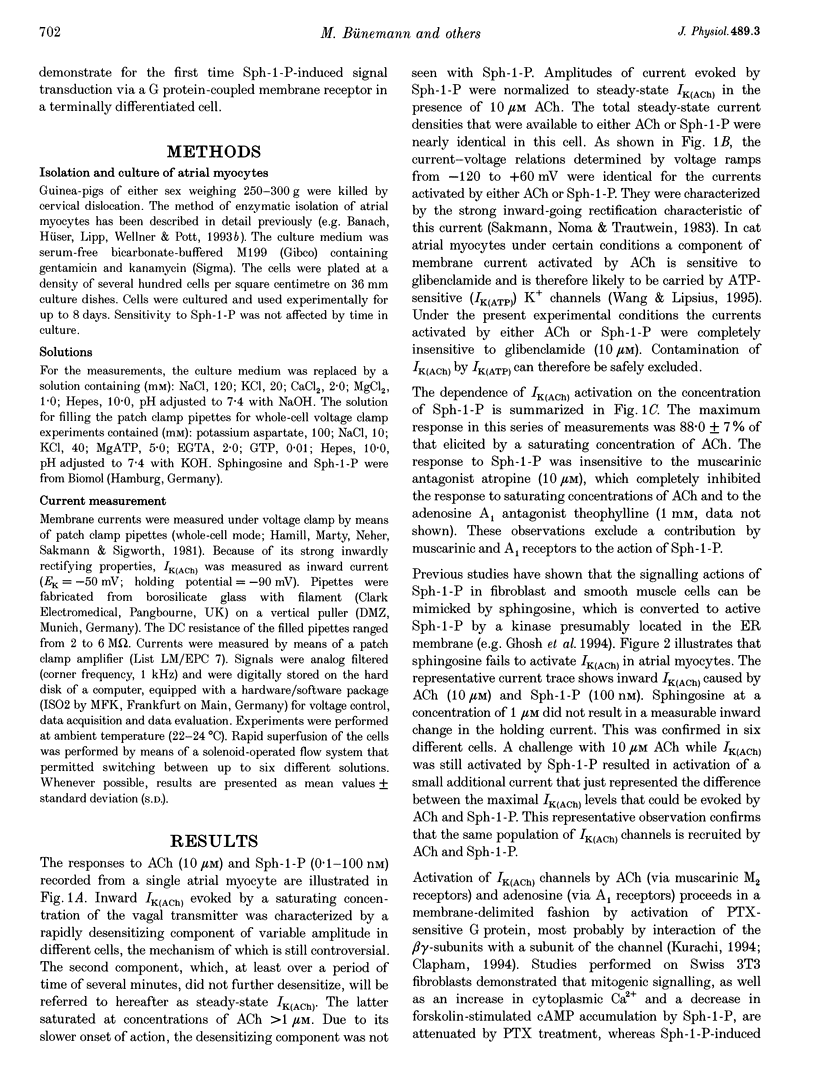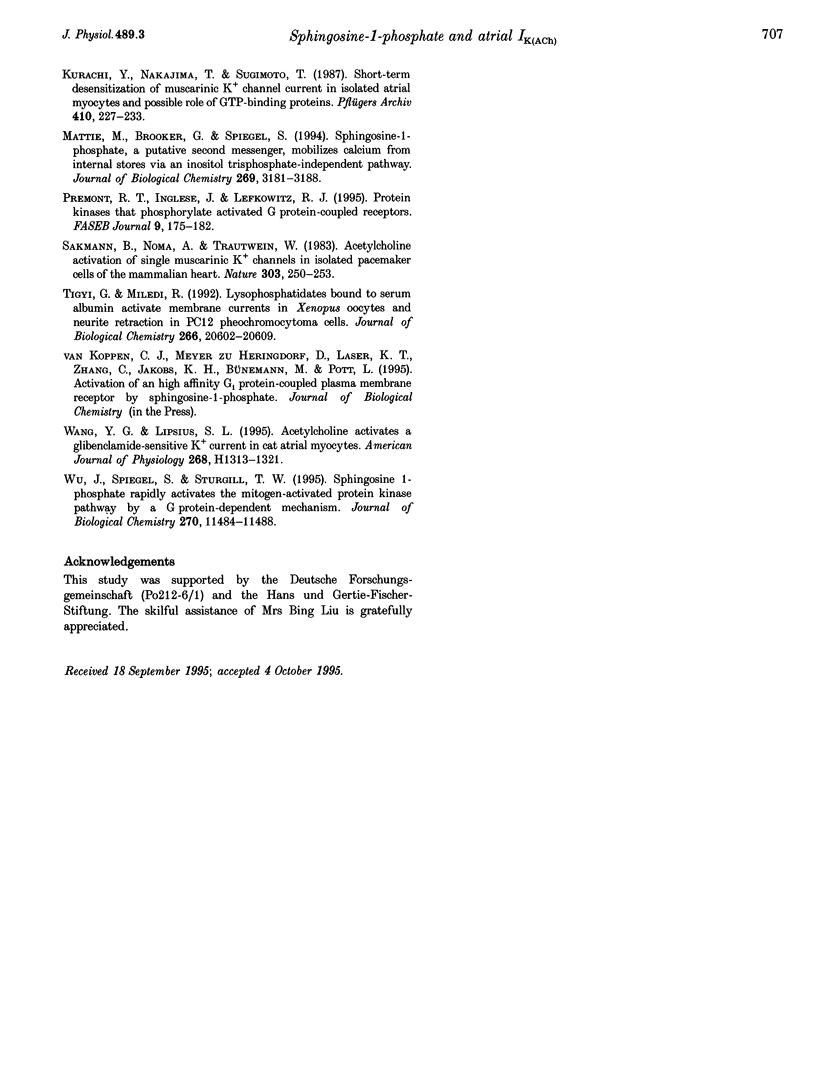Abstract
1. Activation of muscarinic K+ current (IK(ACh)) by sphingosine-1-phosphate (Sph-1-P) was studied in isolated cultured guinea-pig atrial myocytes using whole-cell voltage clamp. 2. Sph-1-P caused activation of IK(ACh) with an EC50 of 1.2 nM. The maximal current that could be activated by Sph-1-P amounted to about 90% of the IK(ACh) caused by a saturating concentration of acetylcholine (ACh, 10 microM). Sphingosine (1 microM), which can mimic the signalling effects of Sph-1-P in other cells, failed to cause measurable activation of IK(ACh). 3. IK(ACh) activation by Sph-1-P was completely suppressed in cells treated with pertussis toxin. 4. Desensitization of muscarinic receptors by pre-incubation of the cells with carbachol did not affect the response to Sph-1-P; likewise, pre-incubation of the cells with Sph-1-P resulted in a reduced sensitivity to the phospholipid but not to ACh. In contrast, pre-incubation with either Sph-1-P or a serum phospholipid previously described as activating atrial IK(ACh) resulted in reduced sensitivity to both phospholipids. 5. It is concluded that activation of IK(ACh) by Sph-1-P in atrial myocytes is induced by binding to a novel G protein-coupled phospholipid receptor.
Full text
PDF






Images in this article
Selected References
These references are in PubMed. This may not be the complete list of references from this article.
- Banach K., Bünemann M., Hüser J., Pott L. Serum contains a potent factor that decreases beta-adrenergic receptor-stimulated L-type Ca2+ current in cardiac myocytes. Pflugers Arch. 1993 May;423(3-4):245–250. doi: 10.1007/BF00374402. [DOI] [PubMed] [Google Scholar]
- Banach K., Hüser J., Lipp P., Wellner M. C., Pott L. Activation of muscarinic K+ current in guinea-pig atrial myocytes by a serum factor. J Physiol. 1993 Feb;461:263–281. doi: 10.1113/jphysiol.1993.sp019513. [DOI] [PMC free article] [PubMed] [Google Scholar]
- Bünemann M., Pott L. Membrane-delimited activation of muscarinic K current by an albumin-associated factor in guinea-pig atrial myocytes. Pflugers Arch. 1993 Nov;425(3-4):329–334. doi: 10.1007/BF00374183. [DOI] [PubMed] [Google Scholar]
- Clapham D. E. Direct G protein activation of ion channels? Annu Rev Neurosci. 1994;17:441–464. doi: 10.1146/annurev.ne.17.030194.002301. [DOI] [PubMed] [Google Scholar]
- Desai N. N., Zhang H., Olivera A., Mattie M. E., Spiegel S. Sphingosine-1-phosphate, a metabolite of sphingosine, increases phosphatidic acid levels by phospholipase D activation. J Biol Chem. 1992 Nov 15;267(32):23122–23128. [PubMed] [Google Scholar]
- Durieux M. E., Salafranca M. N., Lynch K. R., Moorman J. R. Lysophosphatidic acid induces a pertussis toxin-sensitive Ca(2+)-activated Cl- current in Xenopus laevis oocytes. Am J Physiol. 1992 Oct;263(4 Pt 1):C896–C900. doi: 10.1152/ajpcell.1992.263.4.C896. [DOI] [PubMed] [Google Scholar]
- Ghosh T. K., Bian J., Gill D. L. Sphingosine 1-phosphate generated in the endoplasmic reticulum membrane activates release of stored calcium. J Biol Chem. 1994 Sep 9;269(36):22628–22635. [PubMed] [Google Scholar]
- Goodemote K. A., Mattie M. E., Berger A., Spiegel S. Involvement of a pertussis toxin-sensitive G protein in the mitogenic signaling pathways of sphingosine 1-phosphate. J Biol Chem. 1995 Apr 28;270(17):10272–10277. doi: 10.1074/jbc.270.17.10272. [DOI] [PubMed] [Google Scholar]
- Hamill O. P., Marty A., Neher E., Sakmann B., Sigworth F. J. Improved patch-clamp techniques for high-resolution current recording from cells and cell-free membrane patches. Pflugers Arch. 1981 Aug;391(2):85–100. doi: 10.1007/BF00656997. [DOI] [PubMed] [Google Scholar]
- Jalink K., van Corven E. J., Moolenaar W. H. Lysophosphatidic acid, but not phosphatidic acid, is a potent Ca2(+)-mobilizing stimulus for fibroblasts. Evidence for an extracellular site of action. J Biol Chem. 1990 Jul 25;265(21):12232–12239. [PubMed] [Google Scholar]
- Kurachi Y., Nakajima T., Sugimoto T. Short-term desensitization of muscarinic K+ channel current in isolated atrial myocytes and possible role of GTP-binding proteins. Pflugers Arch. 1987 Oct;410(3):227–233. doi: 10.1007/BF00580270. [DOI] [PubMed] [Google Scholar]
- Mattie M., Brooker G., Spiegel S. Sphingosine-1-phosphate, a putative second messenger, mobilizes calcium from internal stores via an inositol trisphosphate-independent pathway. J Biol Chem. 1994 Feb 4;269(5):3181–3188. [PubMed] [Google Scholar]
- Premont R. T., Inglese J., Lefkowitz R. J. Protein kinases that phosphorylate activated G protein-coupled receptors. FASEB J. 1995 Feb;9(2):175–182. doi: 10.1096/fasebj.9.2.7781920. [DOI] [PubMed] [Google Scholar]
- Sakmann B., Noma A., Trautwein W. Acetylcholine activation of single muscarinic K+ channels in isolated pacemaker cells of the mammalian heart. Nature. 1983 May 19;303(5914):250–253. doi: 10.1038/303250a0. [DOI] [PubMed] [Google Scholar]
- Tigyi G., Henschen A., Miledi R. A factor that activates oscillatory chloride currents in Xenopus oocytes copurifies with a subfraction of serum albumin. J Biol Chem. 1991 Nov 5;266(31):20602–20609. [PubMed] [Google Scholar]
- Wang Y. G., Lipsius S. L. Acetylcholine potentiates acetylcholine-induced increases in K+ current in cat atrial myocytes. Am J Physiol. 1995 Mar;268(3 Pt 2):H1313–H1321. doi: 10.1152/ajpheart.1995.268.3.H1313. [DOI] [PubMed] [Google Scholar]
- Wu J., Spiegel S., Sturgill T. W. Sphingosine 1-phosphate rapidly activates the mitogen-activated protein kinase pathway by a G protein-dependent mechanism. J Biol Chem. 1995 May 12;270(19):11484–11488. doi: 10.1074/jbc.270.19.11484. [DOI] [PubMed] [Google Scholar]




